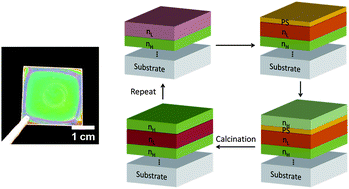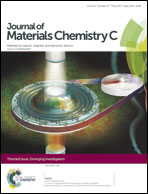Multifunctional all-TiO2 Bragg stacks based on blocking layer-assisted spin coating†
Abstract
Multifunctional all-TiO2 Bragg stacks displaying structural color are fabricated by sequentially spin coating two TiO2 nanoparticles of different shapes and sizes. We find that Bragg stacks generated by simple sequential deposition of the two nanoparticles have poor reflective properties compared to what would be expected based on the optical properties of individual TiO2 nanoparticle layers. This poor photonic property is due to the cross-contamination of neighboring layers during the deposition process; that is, small TiO2 nanoparticles infiltrate the pre-existing TiO2 nanoparticle layers, changing their optical properties. A sacrificial polymer-blocking layer is added between the low- and high-refractive-index layers to prevent their cross-contamination upon fabrication, which, in turn, significantly improves the overall photonic performance of these all-TiO2 Bragg stacks. All-TiO2 Bragg stacks exhibit excellent superhydrophilicity and self-cleaning properties, due to the porosity of the stacked structure and the photocatalytic nature of TiO2 nanoparticles, respectively, enabling patterning of wettability in these multilayer structures. Additionally, we demonstrate that the high quality photonic properties of these all-TiO2 multilayer structures render them ideal for use in enhancing the energy conversion efficiency of dye-sensitized solar cells (DSSCs).

- This article is part of the themed collection: Emerging Investigators

 Please wait while we load your content...
Please wait while we load your content...